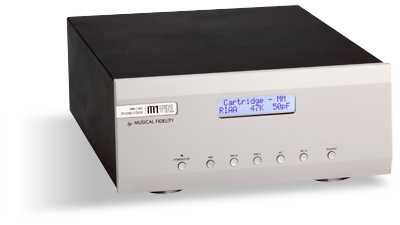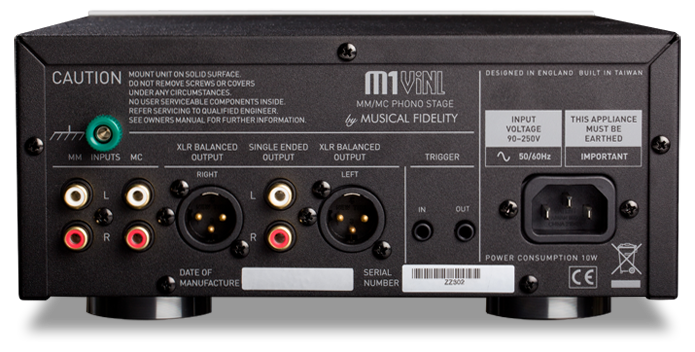
 The British company Musical Fidelity has been designing and producing high-end audio equipment since the 1980s, and most audiophiles have long been familiar with the brand. MF built its reputation on solidly performing gear at moderate prices, but over the years has also offered more upmarket models. Their current line comprises a number of different series targeted at different market segments. The M1 models fall somewhere in the middle: performance that should be a clear step up from the entry level, but at prices that don’t put them out of reach of a wide audience.
The British company Musical Fidelity has been designing and producing high-end audio equipment since the 1980s, and most audiophiles have long been familiar with the brand. MF built its reputation on solidly performing gear at moderate prices, but over the years has also offered more upmarket models. Their current line comprises a number of different series targeted at different market segments. The M1 models fall somewhere in the middle: performance that should be a clear step up from the entry level, but at prices that don’t put them out of reach of a wide audience.
The M1ViNL ($1199 USD) is one of those rare phono preamplifiers that gives equal consideration to both moving-magnet and moving-coil cartridges, with separate inputs for each type that connect to different input stages. If you have two turntables -- one with an MM cartridge, one with an MC -- you could leave both connected, and use the M1ViNL to switch between them. The MM input offers two choices of resistive and eight choices of capacitive loading, the MC input ten choices of resistive loading with a fixed capacitance; equalization is selectable between the standard RIAA and IEC curves. All of these options are available from pushbuttons on the front panel, and can be changed during playback for those audiophiles who insist on trying to tweak the sound of their cartridge in this way from record to record. Shure recommends 47k ohms of resistance and 250pF of capacitance to load my V-15x cartridge. I briefly experimented with other values -- 68k ohms produced a smidge brighter sound, and no obvious difference from changing the capacitance -- but returned to the recommended values for the rest of my listening.
Based on the nominal values stated in the M1ViNL’s specifications, I calculated the gain for MM to be the typical 40dB, but the gain for MC to be a rather low 57dB. Whether that low gain will be a problem or an advantage will depend on the output of your cartridge and the input sensitivity of the next component in the signal chain. A similar system-matching caveat must be given with any fixed-gain device, and shouldn’t be considered a strike against the M1ViNL. There are both single-ended and balanced outputs, the latter generated with a phase splitter -- this is not a balanced circuit.

The circuitry in the M1ViNL is based on instrumentation amplifiers whose low noise and short signal paths contribute to an astonishing 90dB signal/noise ratio for the MM input, and an even more remarkable 88dB for MC (both values A-weighted). Distortion is given as less than 0.01% at 1kHz for either input, and equalization is within 0.2dB all the way up to 50kHz. We don’t measure phono preamplifiers, but if the M1ViNL lives up to these specifications, that would make it one of the most technically excellent phono preamplifiers out there, regardless of price.
The M1ViNL measures 8"W x 4"H x 12"D and weighs a modest 7.75 pounds. It’s a fairly nondescript black box (silver is also available) with a non-dimmable, alphanumeric display across the front. It should slip unobtrusively into any rack of components.
Sound
The M1ViNL’s exceptionally low noise floor meant that music emerged from a nearly silent backdrop. With high-quality audiophile pressings, the background was not quite the inky black of top-flight digital front-ends, but was closer than I would have believed possible. The absence of noise uncovered musically relevant details that would have been partially obscured -- or completely hidden -- by other phono stages. In the rhythmic double-stopped sections of the first movement of Paganini’s Violin Concerto No.1, performed by Itzhak Perlman with Lawrence Foster and the Royal Philharmonic (LP, EMI/HI-Q HIQLP015), I heard Perlman’s bow bouncing on the strings -- and the resulting resonance of his instrument -- as clearly as if I’d been standing on stage next to him. His pizzicato notes had a clean, sharp attack and quick decay. That was in contrast to the plucked notes in Ray Nance’s violin solo in “Mr. Gentle and Mr. Cool,” from the Duke Ellington Orchestra’s Newport 1958 (LP, Columbia/Speakers Corner CS 8072). It made me wonder whether jazz violinists tend to use more of the pad of their fingers to produce greater volume, but a less angular transient than their classical counterparts -- much in the way that jazz double-bassists often place their fingers almost parallel to the strings rather than pulling across the perpendicular.
It was probably this preservation of fine detail that also helped the M1ViNL create large and holographic soundscapes. Good channel separation makes for a wide spread from left to right -- which there was -- but depth, the specific relationships among instruments, and the ambience of the recording venue are in the minute fluctuations of the analog waveform. When random noise competes with that low-level information, the resulting soundstage is flattened and the sound of the hall is lost. A natural soundstage is most often found in recordings of large orchestras -- such as that of Manuel de Falla’s The Three-Cornered Hat (LP, Decca 478 331-1), from the recent Decca Sound boxed set of LPs -- but one occasionally finds examples in other genres. Through the M1ViNL, the above-mentioned Ellington album displayed a soundstage that helped convey the sense of a live event in a large venue rather than a studio, even though I could hear how it had been constructed from multiple microphone feeds.
Perhaps the least obvious benefit of the M1ViNL’s soundstaging abilities was what they did with monaural recordings. With these, depth is the only dimension there is, and the Musical Fidelity’s preservation of that depth kept instruments separated and in some spatial context. Close-miked studio recordings -- which shouldn’t have any genuine soundstage -- were presented with instruments and singers on or just behind the plane defined by the front of the loudspeakers, rather than thrust forward into the room.
The wide variety of instrumental timbres I heard from the many LPs I played through the M1ViNL suggested that it was not overwhelming the original signal by imposing much of its own character. The English horn that introduces the second movement of Rodrigo’s Concierto de Aranjuez, in a 1977 recording by Angel Romero with André Previn and the London Symphony (LP, EMI/Hi-Q HIQLP012), had a warm, covered, plaintive quality, while the massed violins in the same piece were a little too bright -- as was often the case with orchestral recordings of this vintage. The trumpet tone in The Magnificent Thad Jones (LP, Blue Note/Music Matters 1527) is among the best I’ve heard from a classic jazz album, and the M1ViNL gave it a realistic balance of burnished core and metallic brilliance. Roy Eldridge’s trumpet in his Rockin’ Chair (LP, Clef/Speakers Corner MGC 704) was warm and mellow when he played at low volumes, brighter and more aggressive when he pushed the limits of the mike. Voices, too, retained their individual characters: they sounded natural when natural microphone techniques were used, and extra-present when close-miked.
The M1ViNL also produced diverse sounds from bass instruments: sometimes quick and agile, at other times a little round and bloomy. Again, I took this variation as a sign that this phono preamp was passing along the signal it was fed with very little editorializing. With orchestral bass drums -- such as those on Ballet Music from the Opera, by Anatole Fistoulari and the Paris Conservatoire Orchestra (LP, RCA Living Stereo/Alto LSC-2400) -- I heard frequency extension into the bottom octave (I judged this with headphones; my Esoteric MG-10 monitor speakers don’t reach that low), but the drums’ impact was a little lighter than I thought it ought to be. Similarly, the bass line that drives “Whipping Post,” from the Allman Brothers Band’s eponymous first album (LP, Capricorn 835 321-1), was extremely well defined, but less prominent than I’m accustomed to hearing it. While Wilbur Ware’s upright bass on Sonny Rollins’s A Night at the “Village Vanguard” (LP, Blue Note/Classic 1581) sounded a little smaller than the real thing, all other aspects of its timbre, and the nuances of Ware’s playing, were perfectly transmitted by the M1ViNL.
Judging the tonal balance of a phono preamplifier is not as straightforward as evaluating that of a DAC or CD player. Its sound must be taken in combination with the cartridge used, and one can never know what a cartridge “sounds like” on its own -- its signal must always be sent through a phono preamp. All of my assessments were with the Shure V-15x, a cartridge generally regarded as being just to the warm side of neutral, with a well-developed bottom end -- which is what I’ve heard from it through many different phono stages over the years. In that context, the M1ViNL was slightly lean, but I wouldn’t go so far as to call it thin or bright. It emphasized clarity and speed over tonal saturation or bass bloom or slam. But its sound will always, naturally, be highly dependent on the cartridge plugged into it.
Comparison
For the last seven years I’ve owned a Trigon Audio Vanguard II with Volcano II battery power supply (currently $650 each, or $1300 for both). The Vanguard II presents fewer choices for capacitive loading of MM cartridges than does the Musical Fidelity M1ViNL, but a dizzying array of 64 resistive loading options for MC, as well as 16 choices of gain setting ranging from 42 to 66dB. Those additional options mean that the Trigon can be optimized for almost any system. Most users won’t need that level of flexibility, but it’s nice to have if you expect to be changing cartridges or line preamps in the future and want to guarantee their compatibility.
The other significant design difference between these two phono stages is the Trigon’s Volcano II battery power supply; the M1ViNL can be run only directly off the AC line. The theoretical advantage to battery power is that it completely separates the delicate audio amplification circuitry from power-line noise. But while I hear a significant advantage to running the Vanguard II with the Volcano II in full battery mode, it doesn’t reach the same level of quietness as the M1ViNL. The Musical Fidelity’s lower noise floor meant greater detail, better soundstaging, and an overall sense that there was less between me and the recording. With regard to these aspects of performance, I was left with no doubt that the Musical Fidelity presented the music with a higher degree of . . . er . . . fidelity.
The two preamps’ tonal balances, too, were quite different. Although each is a solid-state design based on high-quality integrated circuits, the Vanguard II’s fundamental character is on the warm side of neutral. High frequencies are somewhat subdued, and the midbass has a little extra energy. This warmer sound is more forgiving of less-than-perfect recordings, and those that weren’t engineered for today’s wide-bandwidth systems. For example, The Allman Brothers Band sounded a little raw through the M1ViNL, but was smoothed out through the Vanguard II. The sometimes strident violin sections in older classical recordings were also tempered by the Trigon. These are the compensations you get for giving up the pristine clarity and seemingly limitless HF extension offered by the Musical Fidelity. Which trade-offs you’re willing to make will depend not only on cartridge selection and personal preference, but on the quality and character of the recordings to which you most often listen.
The Vanguard II’s bass goes no deeper than the M1ViNL’s, but it has more power and authority. Bass drums deliver a greater wallop, electric basses are more robust, and acoustic basses seem to have larger bodies. There was more of the initial “kick” to the kick drum on a recent reissue of Sade’s Diamond Life (LP, Epic/Audio Fidelity AFZLP 089) through the M1ViNL, but through the Vanguard II that drum sounded a bit bigger and its energy lasted a bit longer. The electric bass was also a little more prominent in the mix, with a fatter tone, as reproduced by the Trigon. While I found the musical Fidelity’s bass to be a little lighter than strict neutrality, the Trigon’s is a little too heavy. Again, one must consider the partnering equipment. Some turntables and cartridges will produce more bass than my Michell TecnoDec and Shure V-15x, which will result in an overall better balance with the M1ViNL. Some combinations of ’table and cartridge will benefit significantly from the heftier low end of the Vanguard II.
Conclusions
I was thoroughly impressed with the performance of the Musical Fidelity M1ViNL. It’s the cleanest, clearest phono preamplifier I’ve heard in my system. Those qualities allowed me to hear more fine detail than I could have imagined from records I thought I knew well. If you’ve ever had any doubts about vinyl’s potential for being a high-resolution medium, the M1ViNL should help to dispel them.
The M1ViNL does not produce the warm/lush/very smooth sound that is the stereotype of vinyl playback. Instead, it offers speed, agility, openness, and brilliant extended highs without grit or grain. It’s a thoroughly modern-sounding phono preamplifier that makes no apologies for that fact. If those are the qualities you value, you should audition the M1ViNL. Even if you’re prepared to spend far more than $1199, you may find you don’t have to.
. . . S. Andrea Sundaram
andreas@soundstagenetwork.com
Associated Equipment
- Analog source -- Michell TecnoDec with modified Rega RB-300 tonearm, HR power supply, and Shure V-15x cartridge
- Phono stage -- Trigon Audio Vanguard II with Volcano II battery power supply
- Amplifier -- GRAAF GM-50
- Speakers -- Esoteric MG-10
- Headphones --Stax SR-507, Ultrasone PRO 2900
- Headphone amplifiers -- Woo Audio GES, Grace Design m902
- Interconnects --DH Labs Revelation, QED Silver Spiral, JPS Superconductor
- Speaker cables -- DH Labs Q-10
- Power conditioning -- Equi=tech Son of Q
Musical Fidelity M1ViNL Phono Stage
Price: $1199 USD.
Warranty: One year parts and labor.
Musical Fidelity Limited
24-26 Fulton Road
Wembley, Middlesex, England HA9 0TF
UK
Phone: +44 (0)20-8900-2866
Fax: +44 (0)20-8900-2983
Website: www.musicalfidelity.com
North American distributor:
Tempo High Fidelity, LLC
PO Box 541443
Waltham, MA 02454-1443
Phone: (617) 314-9296
Fax: (617) 336-3486
E-mail: info@tempohighfidelity.com
Website: www.tempohighfidelity.com






















